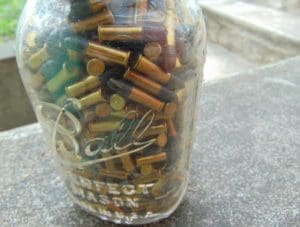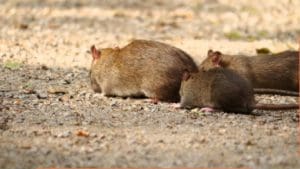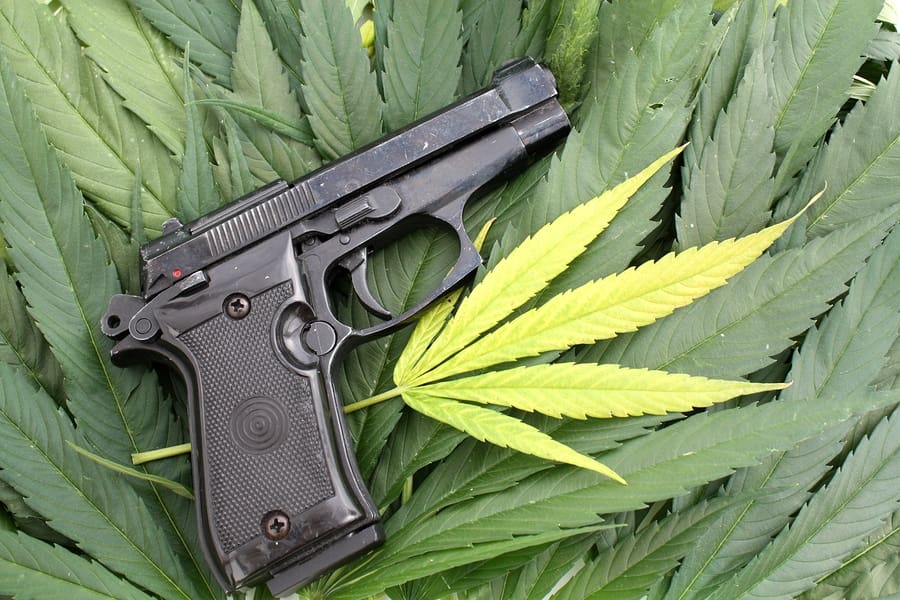Most rat hunting is done with dogs, commonly with varieties of terriers that catch and kill the vermin. The human hunter’s job: flush the rats from cover. The rat hunting record for that method supposedly occurred in England in the 1820’s, when a rat terrier killed an incredible 2,501 rats in seven hours in a barn infested with the rodents. The dog was the renowned Billy, whose career was legendary. I haven’t found contemporary records of the 2,501 rat killing, but they may exist. Most of his records are for killing 100 rats in a rat pit against the clock. Billy’s best was 100 rats in 5 1/2 minutes. I haven’t seen any records for human hunters killing rats . . .
Huge numbers of rats were killed in the “Great Leap Forward” in China (that ended in ecological disaster and famine). In the process they supposedly killed 1.5 billion rats. But given the Chinese predilection for group efforts, it seems unlikely that any records of individual hunts over a few hours exist. But I have the rat killing record of a friend of mine, who wishes to remain anonymous. It happened in the 1950’s, when dumps were unregulated in Wisconsin.
Hunting rats at dumps was a common pastime. I shot rats at dumps into the early 1970’s. It helped keep the population down and increased hunting and shooting skills. My friend, as with many young men of the period, was an avid rat hunter.
He approached rat hunting with his usual rigor and intellect, determining how to obtain maximum returns for his effort. This lead to hunting rats at night with a headlight powered by a six volt Ray O Vac battery. Returning from a night hunt with two hunting partners, he discovered a dump that was a rat hunter’s Mecca. It wasn’t far from his base of operations in Madison, Wisconsin.
He was on the way back from a distant dump, a passenger in one of his partners’ beat-up car. (This was in 1955. I expect the car was pre-World War II.) He could see through cracks in the floorboards.
As the car approached the junction of Highways 12 and 78 on the East side of the Wisconsin River, he saw flames flickering under his feet. It was about 1 am. He notified the driver that they were on fire; the driver pulled over into a service station. The car’s fuel pump was burning. They used sand and gravel to put it out. Then the car refused to start.
As they waited for rescue from Madison, they chatted with the gas station attendant. The attendant asked what they were up to at that time of night. When he heard that they’s been hunting rats, he said he hunted rats at a dump only a mile to the South. He’d shot 10 or 12 in an afternoon. Ten or twelve rats in broad daylight translates to hundreds after dark . . .
The dump was between highway 78 and the railroad tracks. It was an unregulated affair on a few acres of low ground at the edge of the Wisconsin river floodplain. The debris was only eight to 10 feet high, as high as people could easily unload it. Restaurants in the area routinely dumped spoiled and outdated food there. It was a wonderful breeding place for Rattus Norvegicus.
The hunting partners hunted the dump a few times, bagging nearly a hundred rats each. Dane County deputies would stop by and use their .38 revolvers and shotguns to shoot a few rats in the evening. They said hello, but never questioned or detained my friend. There were no nearby houses.
In the spring of 1957, the medical students that had been my friends hunting partners had graduated or transferred. He was the only rat hunter left of the original group. He had also purchased his first car, new, for cash.
Experience had taught him that the best hunting nights were the first warm nights in April. It was likely April 19th, or 20th. Those days were the warmest in April in 1957. The rats had been breeding all winter, virtually unmolested. The new population would not be used to being hunted.

On a warm April night in 1957, he arrived at the dump with his Savage model 29 pump rifle with a 24 inch barrel (above), a High Standard semi-automatic target pistol, and a quart jar of .22 Remington standard velocity .22 long rifle ammunition (around 850 rounds). After sunset, he started hunting rats. The sun went down about 6:45. It was dark enough for hunting by 7 pm.
He loaded the Savage to capacity: filling the magazine tube to the top with long rifle cartridges; 20 rounds. He did this by feel in the dark. The inner tube, follower and spring could not lock with that many in place, so spring tension was maintained by friction. After four or five shots were fired, the inner tube could be inserted the remaining four or five inches and locked. The pistol was used for close shots that presented themselves while he was reloading the rifle. Nearly all shots were under 50 feet, and the rats averaged about 1/4 to 1/2 pound.
The hunting procedure was as follows . . .
He would move 10-15 feet from the last position with his headlight off. Then he would turn on the headlight. Inexperienced rats would freeze in place when the light came on. He would pick those off with the rifle. When he could not see any more targets, he would move another 10 or 15 feet and repeat the procedure. By the time he had made a circumnavigation of the five acre dump, the original position had resumed rat activity and was again available for shooting.
He continued this hunt until 3 a.m., eight hours of shooting. He had shot 365 rats that he was able to recover. That is an average of a rat every 80 seconds. The quart jar was empty. He had expended 850 rounds of ammunition. The light from the Ray O Vac was getting dim.

It was an extraordinary hunt in an extraordinary time at an extraordinary nexus of opportunity, location and skill. My friend, at age 82, has not shot any animals for years. The hunt took place just before his birthday in 1957. He has followed the hunter’s normal progression. But rats, then and now, were vermin whose populations needed to be kept in check. In 1957 he used a rifle and a pistol. Now we use bulldozers.
The old dump has long been abandoned. Almost nothing remains for the casual observer. The five acre site is used to park semi-trailers. On the edge of the site, overgrown with vegetation, a mound, a crumpled rusty commercial sign, a few broken bricks and tiles, show where the boundary of the dump was. The remnants are near the old railroad track. Small trees and brush grow between the ties. The farm crossing is still there. The nearby Boy Scout property is still in use. There is a marble marker commemorating its acquisition.
My friend is a bit obsessive/compulsive. For years he tracked every penny earned and spent. He is meticulous in his record keeping. I firmly believe his 365 number. It was quite an achievement, and a service to the community besides.





“The rat hunting record for that method supposedly occurred in England in the 1820’s, when a rat terrier killed an incredible 2,501 rats in seven hours in a barn infested with the rodents.”
A ‘Target-Rich Environment’, so to say…
Have rats ever been known coordinate an attack on something they clearly perceive as a threat?
Cool story, Dean…
‘Have rats ever been known coordinate an attack on something they clearly perceive as a threat?’
Yeh, of course, you’ve heard of gun control haven’t you?
Hell, I don’t consider gun owners rats; what is wrong with you except that you cannot read English?
Our snipers in Iraq…that was a good rat hunt.
A good shooter could probably reach that number in most New York City parks. The rats are swarming there, and they are very bold.
I hear you can get a bunch at almost any city hall.
I think you are confusing rats with pigs.
Easy mistake. Both are disease ridden and cause massive amounts of damage.
A very easy mistake to make at the White House.
Open air dumps are still around. I go to one in eastern Oregon and plink with the 10-22.
It’s great fun.
Used to do it in Santee, CA when I was in high school.
Good times.
The flashlight/pistol combination was used by some guys in Vietnam whilst they were in underground quarters. A friend who was attached to the Rangers in SEA for a bit described it thusly:
“Everyone would get on one side of the room, leaving a target zone. One guy would be positioned to the left of the man with the 1911; he would use his hearing to locate the rat and describe the exact location to two other men on the right of the shooter. The two men on the right had flashlights.
Upon the ‘radar’ man describing the location accurately, he’d plug his ears with his fingers, the lights men would illuminate the target and the shooter would use the 1911 to blast the rat. The lights would be turned off, the shooter would safe the pistol, the “radar” man would pull his fingers out of his ears and they’d go to work locating the next rat.”
My friend said that this practice seemed insane when you just heard about it, but when you actually saw the size of the rats down in some of these bunkers, you became highly impressed by the competency of the Rangers in dealing with the problem.
When he asked why the Rangers were not using a .22LR, he was told that they could get all the .45 ACP ball they could requisition, but .22LR was hard to come by.
My Dad was a WW2 pilot B-24 bombers stationed in the Po Valley, Italy in the winter of 44-45. They has a rat problem and they would scurry among and within the tents, One pilot would shoot them with his ,45 1911 too. The others were concerned that the potential round bouncing off the ground might hit and injure or kill someone. So , somehow they got a case of .45 ACP shot shells and gave them to the rat shooter as a Christmas gift.
Birdshot and tracer ammo for the .45 acp was issued to flight crews during ww2. Birdshot as a survival aid and tracer as an emergency signal.
Shooting rats might be as much fun as a guy can have with a gun. That being said dogs might love killing the pests even more than we do. I have an old Airedale terrier who has taken her fair share of rats and believe me a terrier that knows what they are doing is a literal terror on any offending rat. Rats don’t have a chance in hell despite what a cartoon may portray, and the dog simply loves it.
Just about every barn and corn crib back home had a resident black snake to help with the rodent problems. Rule of thumb with a farm snake was if it wasn’t a rattler or copperhead and wasn’t messing with the eggs, leave it be.
.22 snake shot out of a smoothbore .22 was pretty decent ina barn or outbuilding without collateral damage. But i figure the snakes got more their way.
Country dumps were good for all sorts of critters, not just rats. Possums were always open season.
My grandfather was also fond of hunting rats at his town dump. I wish I had the same opportunity as a kid. Fvck the EPA.
The numbers sound very realistic: 365 hits out of 850 shots … a little bit better than 1 out of 3. I am going to call this firmly believable.
I read every bit of that thinking it had something to do with the Wisconsin teacher that was ratted out.
This has me all fired up for some rodent ridden’
Off to YouTube to watch some of The Squirrel Hunter’s vids.
https://www.youtube.com/user/squirrelhuntertv
Never shot a rat but long ago I participated in pouring gasoline in rat holes and clubbed the vermin as they scampered out…in back of the Holiday Inn in Bradley,IL. Good times…
We would club em on silage piles at night
Nice 22.
I would like to believe that the presence of this story and the story describing the meeting of the attorney general’s promoting an anti 2A agenda is just a coincidence.
My Rhodesian Ridgeback lives killing rats.
“Billy” the ratter was quite impressive. I called my English Patterdale’s name, she slid off the couch, streched and farted then went and sat in front of the pantry wanting a biscut! I then told her Billy would be ashamed.
I enjoyed the dump rat hunting story. Good times can still be had. Ground Squirls refered to as Whistle Pigs look and act like mini prairie dogs. Note: not all species can be hunted. There can be several hundred to per acre. They chirp warnings and scouts cherp again as they come out and look around. You can set the timmer on a cheap watch to beep at one minute intervals and they will keep coming out. Their main natural predator are hawks so they always watch the sky, coyotes get there fill too. They are cannibalistic and start eating the dead and wounded: the pile gets bigger! Always took two guns to allow cooling time and changed to a bolt gun to slow down my rate of fire! My experences with them were in Western Idaho. 22LR was $7 for a 550 brick and you never went without two of them. I didn’t do body counts, just kept buying bricks/cases.
i speared one in a dumpster with a paslode framing gun.
When I was about 13-14, there was an elderly corn farmer a few miles down the road who had a serious rat problem. His dogs and cats were old too, and no longer had the speed or motivation to do much rodent hunting. So to alleviate the problem, he paid me and a friend of mine 50 cents per rat confirmed dead, along with rhubarb pie and homemade cider that his wife made regularly. I used his old pump Winchester .22 and bought rat-shot ammo or .22 CB shorts, while my buddy had a Browning .22 pistol that was like a lasergun in his hands.
We would head out to his barn around sundown, climb up onto a large beam across from the hayloft, and take turns spotting each other’s targets with old army flashlights. Since we were shooting mainly downwards, we never put many .22 holes in the sides of his barn, and the few that did bounce never had the oomph to penetrate the thick planks. I used the Winchester with ratshot mostly since it had almost no rifling left, and my friend would nail tricky close-in shots, or finish wounded ones off with his Browning. On a good night we would ride home in the dark with $15-$20 between us, which we used to buy more ammo and baseball cards or MAD magazines.
Sometimes I got the feeling that my neighbor was allowing us to hunt rats on his farm mostly to keep us out of trouble, since our efforts never seemed to make much of a dent in the rat population; and their own kids had long grown up & moved away, so his wife enjoyed having us around to keep her pie-making skills sharp.
Many years later, I found a pump Winchester M.1906 just like the one I used to borrow. The dealer I bought it from was in the same town, so I often wonder if I ended up with that very rifle. I’ve replaced a few springs, the extractor, and had a barrel sleeve done by a good gunsmith; to this day it still is my favorite gun. Whenever I shoot it, I think about those times varmint hunting on the farm with my friend.
I would have done it for the rhubarb pie.
I would have done it for the target practice.
good rhubarb pie is nothing to sneeze at, those who dont know need to educate them selves.
” I haven’t seen any records for human hunters killing rats” John Gotti probably kept them……
Thanks for a great story!
Comments are closed.